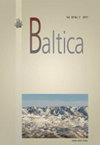Modelling of glacially-induced stress changes in Latvia, Lithuania and the Kaliningrad District of Russia
IF 0.6
4区 地球科学
Q4 GEOLOGY
引用次数: 8
Abstract
We model the change of Coulomb Failure Stress (δCFS) during the Weichselian glaciation up until today at 12 locations in Latvia, Lithuania and Russia that are characterised by soft-sediment deformation structures (SSDS). If interpreted as seismites, these SSDS may point to glacially-induced fault reactivation. The δCFS suggests a high potential of such reactivation when it reaches the instability zone. We show that δCFS at all 12 locations reached this zone several times in the last 120,000 years. Most notably, all locations exhibit the possibility of reactivation after ca. 15 ka BP until today. Another time of possible activity likely happened after the Saalian glaciation until ca. 96 ka BP. In addition, some models suggest unstable states after 96 ka BP until ca. 28 ka BP at selected locations but with much lower positive δCFS values than during the other two periods. For the Valmiera and Rakuti seismites in Latvia, we can suggest a glacially-induced origin, whereas we cannot exactly match the timing at Rakuti. Given the (preliminary) dating of SSDS at some locations, at Dyburiai and Ryadino our modelling supports the interpretation of glacially-induced fault reactivation, while at Slinkis, Kumečiai and Liciškėnai they likely exclude such a source. Overall, the mutual benefit of geological and modelling investigations is demonstrated. This helps in identifying glacially-induced fault reactivation at the south-eastern edge of the Weichselian glaciation and in improving models of glacial isostatic adjustment.拉脱维亚、立陶宛和俄罗斯加里宁格勒地区冰川引起的应力变化的模拟
我们在拉脱维亚、立陶宛和俄罗斯的12个以软沉积变形结构(SSDS)为特征的地点,模拟了魏奇塞利冰期至今库仑破坏应力(δCFS)的变化。如果将其解释为震积岩,这些固态岩石可能指向冰川引起的断层再活化。δCFS表明,当到达不稳定区时,这种再活化的电位很高。我们发现,在过去的12万年里,所有12个地点的δCFS都多次达到这个区域。最值得注意的是,直到今天,所有地点都显示出大约15 ka BP之后重新激活的可能性。另一个可能的活动时间可能发生在萨利安冰期之后,直到大约96 ka BP。此外,一些模式表明,在选定的位置,96 ka BP之后至约28 ka BP的不稳定状态,但正δCFS值远低于其他两个时期。对于拉脱维亚的Valmiera和Rakuti震积岩,我们可以提出冰川诱发的起源,但我们无法精确匹配Rakuti的时间。在Dyburiai和Ryadino,我们的模型支持冰川诱导断层重新激活的解释,而在Slinkis, kume iai和Liciškėnai,他们可能排除了这种来源。总的来说,地质和模拟调查的相互效益得到了证明。这有助于在魏希塞利期冰川东南缘确定冰川引起的断层恢复活动,并有助于改进冰川均衡调整模式。
本文章由计算机程序翻译,如有差异,请以英文原文为准。
求助全文
约1分钟内获得全文
求助全文
来源期刊

Baltica
地学-地质学
CiteScore
1.30
自引率
14.30%
发文量
6
审稿时长
>12 weeks
期刊介绍:
BALTICA is an international periodical journal on Earth sciences devoted to the Baltic countries region and the Baltic Sea problems. This edition as a Yearbook is established in 1961 by initiative of Academician Vytautas Gudelis. Since 1993, an Editor-in-Chief of the journal became Academician Algimantas Grigelis. BALTICA is published biannually (in June and December) in cooperation with geoscientists of the circum-Baltic States.
BALTICA is publishing original peer-reviewed papers of international interests on various Earth sciences issues. The particular emphasis is given to Quaternary geology, climate changes and development of ecosystems, palaeogeography, environmental geology, as well as stratigraphy, tectonics, sedimentology and surface processes with relevance to the geological history of the Baltic Sea and land areas. Journal emphasizes modern techniques, methodology and standards. The journal structure comprises original articles, short reviews, information, bibliography.
 求助内容:
求助内容: 应助结果提醒方式:
应助结果提醒方式:


